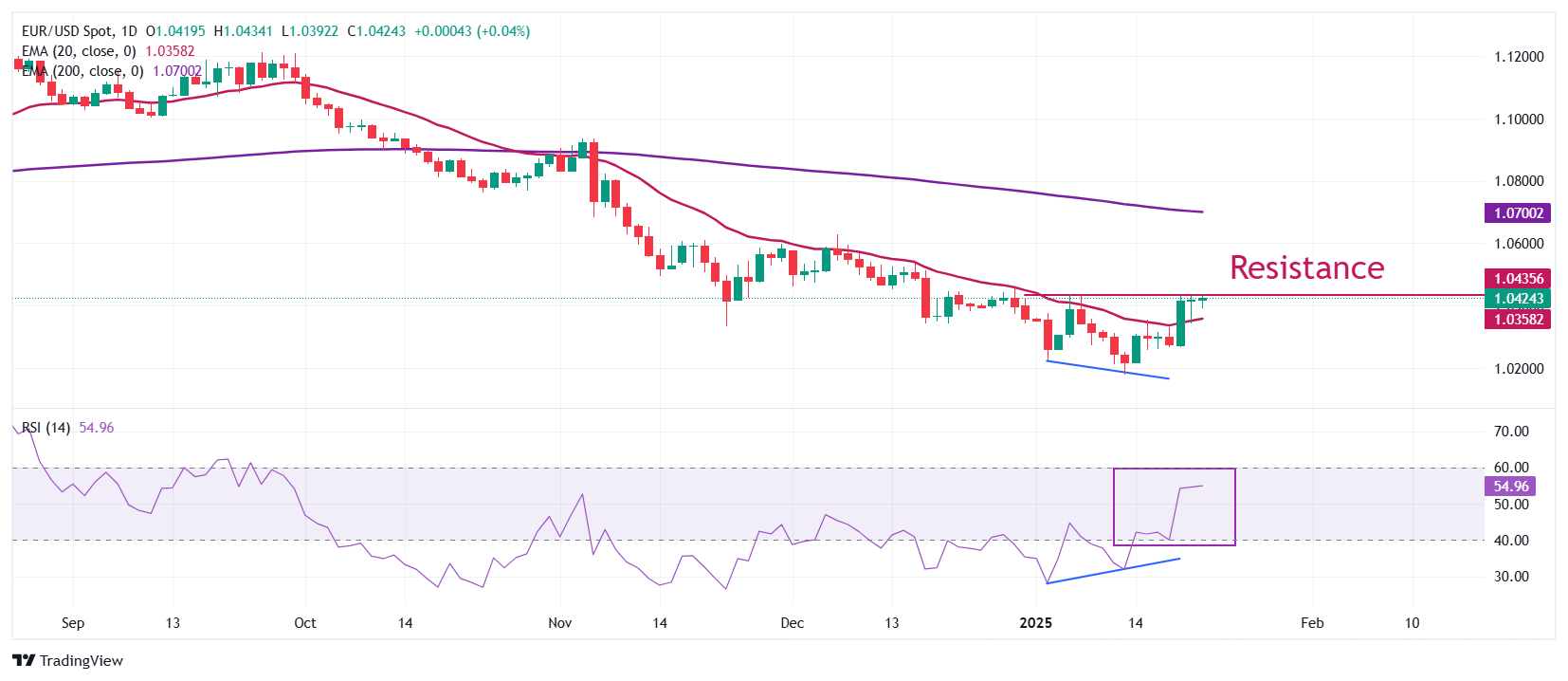EUR/USD gains as Trump’s moderately fearful tariff plan diminishes USD’s appeal
- EUR/USD remains firm above 1.0400 as US President Donald Trump has announced lower-than-anticipated tariffs on China.
- ECB’s Lagarde warned that the Euro bloc should be prepared for US tariffs.
- ECB’s Stournaras commented that the policy-easing pace could accelerate if the US imposes tariffs on the Eurozone.
EUR/USD clings to gains above the key support of 1.0400 in Wednesday’s European session after a strong recovery move in North American trading hours on Tuesday. The major currency pair remains firm while investors gauge explicit United States (US) tariff plans to build fresh positions.
In two working days, US President Donald Trump has announced 25% tariffs on Mexico and Canada and 10% on China, which will come into effect on February 1. Trump has also threatened to fix trade imbalances with the Eurozone but has not yet provided clear details. On Monday, Trump said he would remedy the trade imbalance either by “raising tariffs or Europe buying more US oil and gas”.
These tariff calls appear less fearful than what market participants had anticipated from Trump’s election campaign comments, diminishing the US Dollar’s (USD) safe-haven demand. The US Dollar Index (DXY), which tracks the Greenback’s value against six major currencies, trades with caution to near its two-week low of 107.90.
Daily digest market movers: EUR/USD remains firm despite ECB Stournaras sees interest rates near 2% by 2025
- EUR/USD has significantly recovered in the past few trading days. However, its outlook remains uncertain, as President Trump has threatened to impose tariffs on the Eurozone. Additionally, the European Central Bank (ECB) is expected to unwind its policy restrictiveness further and move toward the neutral target of 2%.
- In response to Trump’s threat of tariff hikes, European Union (EU) ministers have commented that they should improve the bloc’s competitiveness and developing capital markets rather than retaliate. ECB’s President Christine Lagarde said in an interview with CNBC on the sidelines of the World Economic Forum (WEF) on Wednesday that Europe must be “prepared for any US tariffs”. Lagarde added that tariffs would be more “selective.”
- EU-US trade relations have also worsened because of Trump’s withdrawal of American membership from the Paris Climate Agreement, which directs members to establish their own targets for reducing greenhouse gas emissions.
- On the monetary policy front, traders price in four 25 basis points (bps) interest rate cuts by the ECB coming consecutively in the next four meetings. ECB policymaker and the Governor of the Bank of Greece Yannis Stournaras said that interest rate cuts should be at the order of “25 bps each time to get close to 2% by the end of 2025”. Stournaras warned that possible US tariffs would “speed up interest rate cuts” in the Eurozone.
Technical Analysis: EUR/USD clings to gains around 1.0430

EUR/USD trades firmly near its two-week high of 1.0430 in Wednesday’s European session after rebounding from an over two-year low of 1.0175. The major currency pair recovered after a divergence in momentum and price action. The 14-day Relative Strength Index (RSI) formed a higher low, while the pair made lower lows. The negative divergence would be confirmed if the pair decisively breaks above the immediate resistance of 1.0440
The near-term outlook of the shared currency pair has improved as it has climbed above the 20-day Exponential Moving Average (EMA), which trades around 1.0358. Meanwhile, the longer-term outlook is still bearish as the 200-day EMA at 1.0700 is sloping downwards.
Looking down, the January 13 low of 1.0175 will be the key support zone for the pair. Conversely, the psychological resistance of 1.0500 will be the key barrier for the Euro bulls.
Euro FAQs
The Euro is the currency for the 19 European Union countries that belong to the Eurozone. It is the second most heavily traded currency in the world behind the US Dollar. In 2022, it accounted for 31% of all foreign exchange transactions, with an average daily turnover of over $2.2 trillion a day. EUR/USD is the most heavily traded currency pair in the world, accounting for an estimated 30% off all transactions, followed by EUR/JPY (4%), EUR/GBP (3%) and EUR/AUD (2%).
The European Central Bank (ECB) in Frankfurt, Germany, is the reserve bank for the Eurozone. The ECB sets interest rates and manages monetary policy. The ECB’s primary mandate is to maintain price stability, which means either controlling inflation or stimulating growth. Its primary tool is the raising or lowering of interest rates. Relatively high interest rates – or the expectation of higher rates – will usually benefit the Euro and vice versa. The ECB Governing Council makes monetary policy decisions at meetings held eight times a year. Decisions are made by heads of the Eurozone national banks and six permanent members, including the President of the ECB, Christine Lagarde.
Eurozone inflation data, measured by the Harmonized Index of Consumer Prices (HICP), is an important econometric for the Euro. If inflation rises more than expected, especially if above the ECB’s 2% target, it obliges the ECB to raise interest rates to bring it back under control. Relatively high interest rates compared to its counterparts will usually benefit the Euro, as it makes the region more attractive as a place for global investors to park their money.
Data releases gauge the health of the economy and can impact on the Euro. Indicators such as GDP, Manufacturing and Services PMIs, employment, and consumer sentiment surveys can all influence the direction of the single currency. A strong economy is good for the Euro. Not only does it attract more foreign investment but it may encourage the ECB to put up interest rates, which will directly strengthen the Euro. Otherwise, if economic data is weak, the Euro is likely to fall. Economic data for the four largest economies in the euro area (Germany, France, Italy and Spain) are especially significant, as they account for 75% of the Eurozone’s economy.
Another significant data release for the Euro is the Trade Balance. This indicator measures the difference between what a country earns from its exports and what it spends on imports over a given period. If a country produces highly sought after exports then its currency will gain in value purely from the extra demand created from foreign buyers seeking to purchase these goods. Therefore, a positive net Trade Balance strengthens a currency and vice versa for a negative balance.


